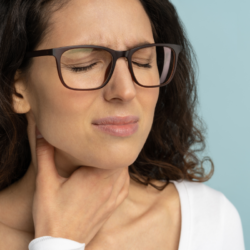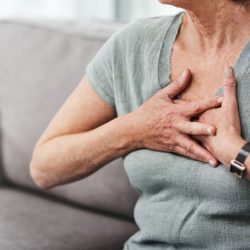Influenza is a contagious viral disease caused by the myxovirus influenzae, of which there are three known types: A, B, C and several subtypes. Although this virus confers immunity through the secretion of antibodies against the envelope antigen, the same individual may develop influenza-like illness several times in his or her life. This virus is liable to mutate its genetic capital during replication, so there is no cross-immunity between the different subtypes.
Influenza and flu syndromes
This disease evolves in an epidemic mode, with type A myxoviruses sometimes going so far as to cause veritable pandemics. Some of these, such as the “Spanish flu” of 1918, the “Asian flu” of 1957-1958 and the “Hong Kong flu” of 1968, have gone down in history. Other viruses, such as myxoviruses and adenoviruses of the ECHO group, are also responsible for very similar clinical pictures labelled “flu syndromes“.
Once a person has been infected, the spontaneous clinical expression of this infectious disease is characterised successively by:
- A silent incubation period lasting 2 to 5 days.
- A brief, sudden onset of fever, with chills, facial congestion and/or aches and pains.
- A state phase lasting several days, with fever and tachycardia, sweating, intense headaches sometimes accompanied by photophobia, aches and pains, ENT catarrh and reduced sterility. This phase usually develops in two stages. During this phase, respiratory, laryngeal, digestive, pericardial and/or neurological complications may arise.
- Defervescence, often accompanied by a long-lasting cough.
- Convalescence, with a period of asthenia of varying length, which may last several weeks.
The role of homeopathy in flu syndromes
When used in acute conditions, homeopathy can shorten the duration of each phase of the infectious disease. All the more so as the treatment is started earlier. Cures are particularly rapid if the medicines are administered at the start of the illness, with the infected person’s reactions causing the infectious syndrome to disappear within a few hours. Given the epidermal way in which flu spreads, it is useful to try to protect unaffected individuals by recommending a preventive homeopathic treatment that is easy to follow.
Incubation period for flu-like illnesses
As this phase is clinically silent, if there is a risk of contagion, Oscillococcinum is used in one dose, repeated twice at 6-hour intervals (i.e. 3 doses in all).
Its very high amino acid content is probably responsible for potentiating the body’s defence mechanisms against infectious agents in general and viruses in particular. So, in almost all cases, flu-like symptoms will not occur.
The invasion period for flu syndromes
This may be sudden or more gradual.
Sudden onset :
This is characterised by the onset of an acute febrile syndrome, leading to a choice between Aconitum and Belladona.
-
Aconitum napellus :
Pathogenetic experimentation with aconite produces, after a chill, a high hyperthermia, with a very rapid onset and cardiac erethism, redness and heat of the skin, which is dry, intense thirst (for cold water) and sthenic agitation. This condition is often seen after a sudden chill, and often begins at night (around midnight or 1am), waking the patient, who may be anxious. Reflex earache and coughing may also be observed.
Dosage: Take in medium dilution 7 or 9CH, as there are both local and general symptoms, either one dose or 5 granules repeated every half hour or every hour until sweating appears.
Then take:
-
Belladonna :
Pathogenetic experimentation with belladonna produces a rapid onset of hyperthermia, progressing in bells, with cardiac erethism and cephalic congestion accompanied by pulsating pain, redness and radiant heat of the skin, sweating, especially of the face; there is also intense thirst due to dryness of the mouth and other mucous membranes (sometimes dysphagia), photophobia due to mydriasis, sensory hyperaesthesia (to noise, touch, shaking) and agitation with the possibility of delirium or despondency.
In practice, as the pathogenetic picture of Belladonna is very similar to that of Aconitum, but differs essentially only in the presence of sweating, the indication for Belladonna follows that of Aconitum as soon as sweating appears.
Dosage: Take Belladonna 7 or 9CH granules (depending on whether there are local or general symptoms), in doses of 5 granules, repeated approximately every hour. Space the doses out progressively as the symptoms improve.
Progressive invasion phase :
This phase is generally characterised by a feeling of initial malaise with chills, headaches, aches and pains and coughing. Oscillococcinum should be taken in one dose as soon as possible, repeated 6 and 12 hours later; the first dose being followed an hour later by :
-
Sulfur :
Dosage : One dose tube in 15 or 30CH. If another dilution is to be used, it is essential to check the integrity of the eardrums (especially in children). Low dilutions of Sulfur may encourage the development of underlying otitis.
The invasion phase is the last stage at which the symptoms can be reversed within a few hours, and we stress the importance of starting homeopathic treatment as soon as the first symptoms appear.
The state of flu syndromes
The patient does not yet benefit from homeopathic medicines during the invasion period and the flu syndrome sets in. Depending on the patient’s symptoms, you should choose one of the following medicines:
Gelsemium :
This remedy, in granule form, is taken in patients presenting with an adynamic febrile syndrome with a high fever that gradually takes hold, frontal and occipital headache, drowsiness, shivering that can go as far as trembling, followed by sweating. This febrile patient is not thirsty; he complains of fatigue and aches.
Dosage : Take 7 or 9CH, 5 granules every hour or every 2 hours depending on the severity of the case. Space out according to improvement.
Rhus toxicodendron :
This natural remedy is indicated for patients presenting with a febrile adynamic syndrome with high fever of progressive onset, accompanied by aches and pains around the joints with stiffness; the improvement through movement, characteristic of this pathogenesis, is expressed by the constant need to move around in bed, with the impression of never finding a comfortable place. The patient seeks warmth, buried under the covers, sweats profusely and shivers or coughs as soon as he uncovers himself, feeling as if ice water were being poured over him.
Thirst is intense for cold water or milk. There may be redness at the tip of the tongue and sometimes an outbreak of perioral herpes. In the latter case, take Rhus toxicodendron 15CH, otherwise take 7 or 9CH, 5 granules every hour or every 2 hours depending on the severity of the case. Space out according to improvement.
Eupatorium perfoliatum :
Medicine for adynamic febrile syndrome with muscular and bone pain, headache and especially eye pain aggravated by pressure on the globes. Often associated rhinitis and tracheobronchial cough, aggravated at night, lying on the back, breathing in cold air. The patient thirsts for cold water.
Dosage: Take 7 or 9CH, 5 granules every hour or every 2 hours depending on the severity of the case. Space out according to improvement.
The 3 medicines listed above have pathogeneses which frequently cover all the symptoms of influenza. However, during the course of a flu syndrome, different clinical pictures may be observed which justify the use of other medicines:
Bryonia alba :
This medicine is indicated for continuous or recurrent febrile states, with headaches, aches and pains in the joints and a dry tracheal cough. All these symptoms are aggravated by movement, forcing the patient to remain immobile in bed and to compress the chest wall when coughing. Sweats are oily, thirst is intense and there is a bitter taste in the mouth.
Dosage : Take 7 or 9CH 5 granules every hour or every 2 hours.
Ferrum phosphoricum :
This medicine is used in cases of low fever. The discharge alternates between pallor and congestion, the skin is clammy. There is a tendency to haemorrhage, reflected in the occurrence of epistaxis, and a tendency to localised congestive phenomena: otalgia with inflamed eardrum or cough due to tracheitis.
Dosage : Take 7 or 9CH 5 granules every hour or every 2 hours, except in cases of otalgia, where 2 doses per day should not be exceeded.
Pyrogenium :
This biotherapy is indicated in the presence of a febrile syndrome in which there is a dissociation of the pulse from the temperature (most often a rapid pulse for a low fever). The patient feels achy and needs to change position, as if in a bed that is too hard. The breath is foul and thirsty.
Dosage : Take 7 or 9CH; 5 granules morning and evening.
Baptisia tinctoria :
The adynamic febrile state is accompanied by mental confusion (or delirium) or an attack on the digestive tract: foul-smelling breath and diarrhoea, intense thirst. There is tenderness in the right iliac fossa and a gurgling cecum. This natural remedy is particularly suitable for flu syndromes with digestive involvement.
Dosage : Take 7 or 9CH, 5 granules every hour or every 2 hours, depending on the severity of the symptoms; space out as symptoms improve.
When homeopathic treatment is started during the acute period, the syndrome is relieved within a few days without complications or severe post-influenza asthenia.Oscillococcinum may still be prescribed, but at this stage its efficacy is much less obvious and regular than during the incubation or invasion periods.
The convalescence period for flu syndromes
Patients may consult their doctor because of post-influenza asthenia, sometimes accompanied by a post-influenza cough that they are unable to get rid of. In such cases, it is possible to encourage the patient to react by choosing one of the following medicines:
Sulfur iodatum :
This drug seems to promote a decongestant and anti-inflammatory reaction which corresponds to the pathophysiological needs encountered at the end of acute infections, particularly those of a respiratory nature.
When should the remedy Sulfur iodatum be taken?
Sulfur Iodatum, also known as Sulphur Iodide, is a homeopathic remedy frequently used in a variety of conditions. Here are some indications for its use:
- Respiratory conditions: Sulfur Iodatum is often recommended to treat the symptoms of respiratory diseases, including chronic bronchitis, asthma and rhinitis, particularly when accompanied by a hacking cough and mucus.
- Dermatological problems: This remedy may be useful in the treatment of certain skin conditions, such as eczema, acne, and skin rashes, especially when they are characterised by oozing lesions or itching.
- Glandular disorders: Sulfur Iodatum is sometimes prescribed for glandular problems, particularly swollen lymph nodes or thyroid disorders.
- Allergies: It can be effective in relieving allergy symptoms, such as runny nose, sneezing and eye irritation.
- General Fatigue: In homeopathy, this remedy is sometimes used to combat general fatigue or lack of energy, particularly when associated with chronic conditions.
Dosage: take 5 granules of Sulfur iodatum 9CH every evening at bedtime until symptoms disappear. In the case of a stubborn cough, the medicine should be supplemented with those indicated for bronchitis or pneumopathy. In the case of isolated post-influenza asthenia, it will be supplemented by one or more of the following medicines:
China rubra :
This medicine is used to treat physical asthenia, with pallor and hypotension, in patients who have lost a lot of body fluids (sweating or diarrhoea).
Dosage: Take 7 or 9CH, 5 granules 2 times a day until symptoms disappear (usually about ten days).
Kalium phosphoricum :
This medicine is taken in cases of psychological asthenia with a lack of taste for work, the slightest intellectual effort leading to great fatigue. The patient is also very hypersensitive to the senses and is somewhat irritable.
The dosage is the same as for China; if necessary, alternate China and Kalium phosphoricum.
Influenzinum :
A biotherapy prepared from the Institut Pasteur’s influenza vaccine, its use is justified at the end of treatment when influenza sequelae persist (persistent cough, persistent anosmia, etc.) In this case, a single-dose 15 CH tube is prescribed as an aetiological medicine.
When should I take the homeopathic remedy Influenzinum?
- Prevention of influenza: Influenzinum 9CH is frequently used as a preventive measure against influenza. It is often recommended at the start of the flu season to help boost immunity against the dominant flu virus strains.
- Flu symptoms: Although mainly used as a preventative, Influenzinum can also be taken when flu symptoms such as fever, muscle aches, fatigue and headaches occur.
- Post-flu: In some cases, this remedy is used to help recovery after flu, particularly when convalescence is slow and the person still feels tired and weak.
- Flu Syndromes: It may be indicated in the treatment of flu syndromes, such as frequent colds, particularly in people with low immunity or who are prone to repeated respiratory infections.







